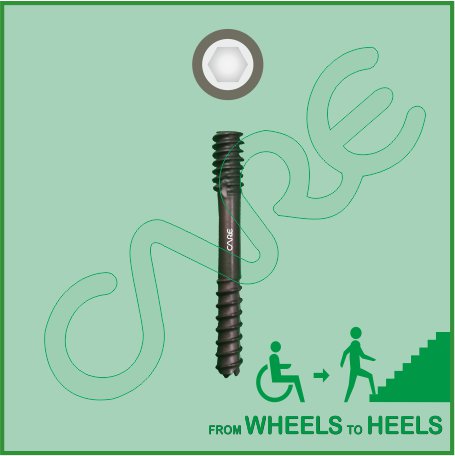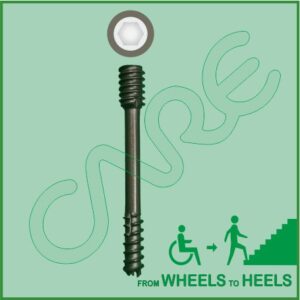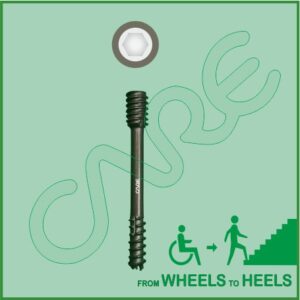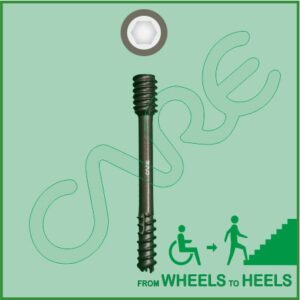Description
| Ref. No. | Description | Material |
| 273514-Ti | Herbert Screw 2.7/3.5mm, 14mm | Titanium |
| 273516-Ti | Herbert Screw 2.7/3.5mm, 16mm | Titanium |
| 273518-Ti | Herbert Screw 2.7/3.5mm, 18mm | Titanium |
| 273520-Ti | Herbert Screw 2.7/3.5mm, 20mm | Titanium |
| 273522-Ti | Herbert Screw 2.7/3.5mm, 22mm | Titanium |
| 273524-Ti | Herbert Screw 2.7/3.5mm, 24mm | Titanium |
| 273526-Ti | Herbert Screw 2.7/3.5mm, 26mm | Titanium |
| 273528-Ti | Herbert Screw 2.7/3.5mm, 28mm | Titanium |
| 273530-Ti | Herbert Screw 2.7/3.5mm, 30mm | Titanium |
| 273535-Ti | Herbert Screw 2.7/3.5mm, 32mm | Titanium |
| 273540-Ti | Herbert Screw 2.7/3.5mm, 34mm | Titanium |
| 273545-Ti | Herbert Screw 2.7/3.5mm, 36mm | Titanium |
| 273550-Ti | Herbert Screw 2.7/3.5mm, 38mm | Titanium |
Herbert Screw 2.7mm/3.5mm Specification
- Herbert Screws have headless design, it means that the screw is completely embedded in the bone, without any protrusions to cause tissue irritation even in intra-articular placement.
- Cannulation helps ensure precise placement of the screw.
- The thread design of the Herbert Screw creates compression and provides fracture stability. As the proximal threads engage the bone, the fracture is drawn together, helping to create and maintain stability of the fracture site.
- Herbert Cannulated Guide Pins hold the fragment and act as guides for drilling, tapping, and screw placement.
- Herbert Screw 2.7mm/3.5mm available lengths are 14mm, 16mm, 18mm, 20mm, 22mm, 24mm, 26mm, 28mm, 30mm, 32mm, 34mm, 36mm and 38mm.
- Herbert Screw 2.7mm/3.5mm is made from pure Titanium and SS 316L.
- Any additional length sizes of this screw will be made on demand.
- Instruments are available for this screw such as Bone Taps, Combined Drill & Tap Sleeve, Counter Sink, Depth Gauge, Drill Bits, Drill Guide, Drill Sleeve, Hollow Mill Screw Removal, Reverse Measuring Device, Screw Drivers and Screw Holding Forceps etc.
Herbert Screw 2.7mm/3.5mm uses
Herbert Screws are designed for the management of fractures where minimal tissue coverage makes standard screw use inappropriate or where extreme precision in fragment alignment is imperative. Such locations might include fractures of the: Olecranon and malleolar region, Distal femur, Proximal tibia, Distal tibia.
Herbert Screw 2.7mm/3.5mm are intended for fixation of intra-articular and extra-articular fractures and non unions of small bones and small bone fragments; arthrodeses of small joint; bunionectomies and osteotomies, including scaphoid and other carpal bones, metacarpals, tarsals, metatarsals, patella, ulnar styloid, capitellum, radial head and radial styliod.
Herbert Screw 2.7mm/3.5mm Surgical Technique
STEP 1: Guide Pin
After initial reduction of the fracture fragments is obtained, the specifically designed Herbert Cannulated Guide Pin is placed through the fragments to act as a Guide Wire for the rest of the placement operation. The Guide Pin should not perforate the opposite cortex.
STEP 2: Depth Gauge
Use the Depth Gauge to measure the length of the Guide Pin in the bone. If the Guide perforates the opposite cortex, corresponding compensation
must be made when selecting the implant length.
STEP 3: Proximal Drill Bit
Insert the Proximal Drill Bit over the Guide Pin to drill the cortex. The Drill Bit should be advanced until the built-in stop contacts the cortex of the bone.
STEP 4: Distal Drill Bit
Insert the Distal Drill Bit over the Guide Pin and drill to the desired depth. At this time the surgeon may choose to drill 5mm less than the
pilot length.
STEP 5: Cannulated Tap
Insert the Cannulated Tap over the Guide Pin and tap the channel to prepare for the leading screw threads of the implant. Tap depth should be equal to the depth created by the Distal Drill Bit.
STEP 6: Insert Screw
In determining screw length, the surgeon may wish to choose an implant 5mm to 10mm shorter than the measured pilot length. Using the Cannulated Screwdriver, insert the Herbert Cannulated Screw. As the trailing threads engage the bone, reduction is achieved. These trailing threads should be seated approximately 1mm below the cortex of the bone to ensure that there is no intra-articular protrusion or interference with the joint
function.
Bone screws are the most commonly used orthopedic implants. There are many different types and sizes of screws for different types of bones. Most bone screws are made out of stainless steel or titanium alloys. The outer diameter, root diameter, and thread pitch and angle are important in determining screw mechanics.
In orthopedics, screws are typically described by their outer diameter, for example, a “Herbert Screw 2.7mm/3.5mm” has an outside diameter of 3.5 mm. The pitch of a screw is the linear distance travelled by a screw for one full turn of the screw. The screw advances by a distance equal to the distance between the threads with each full turn. Cortical screws have a lower pitch and therefore more number of threads. Cancellous bone screws have a greater depth of the screw to increase the surface area and therefore improve the purchase, as the bone is weaker.
Screws function by converting the tightening torque into internal tension in the screw and elastic reactions in the surrounding bone. This creates compression between the fracture fragments that the screw is holding together. Herbert Screw 2.7mm/3.5mm is typically inserted into holes drilled equal to the root diameter and are either self-tapping or are inserted tapped (threaded) holes. The torque to insert cortical bone screws can be high, so the screws must be properly inserted into the correct size drilled hole and designed to withstand insertion torque levels expected in cortical bone. Cancellous bone screws have large, deep threads that grip the spongy bone well. Because of the relatively low strength of the cancellous bone, failure of the screw itself during insertion is rare, but pull out can be an issue.
 CARE IMPLANTS & INSTRUMENTS
CARE IMPLANTS & INSTRUMENTS





